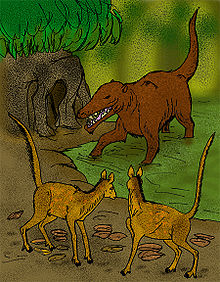Diacodexis
| Diacodexis | |
|---|---|

| |
| Diacodexis pakistanensis and Pakicetus inachus | |
| Scientific classification | |
| Domain: | Eukaryota |
| Kingdom: | Animalia |
| Phylum: | Chordata |
| Class: | Mammalia |
| Order: | Artiodactyla |
| Family: | †Diacodexeidae |
| Genus: | †Diacodexis Cope, 1882 |
| Species | |
| |
Diacodexis is an extinct genus of small herbivorous mammals belonging to the family Diacodexeidae[1][2][3] that lived in North America, Europe and Pakistan from 55.4 mya to 46.2 mya and existing for approximately 9.2 million years.
Description
[edit]
Diacodexis is the oldest known even-toed ungulate. In life, it would have resembled a modern duiker, measuring about 50 centimetres (1.6 ft) in body length, but with a much longer tail. Unlike most later species of artiodactyl, it still had five toes on each foot, although the third and fourth toes were already elongated. It may also have had small hooves on each toe. Its teeth suggest that it was a herbivorous browser.[4]
As suggested by its long legs, Diacodexis is believed to have been fast-running, capable of leaping relatively far.
Fossil distribution
[edit]Diacodexis was widespread, with fossils having been found in Pakistan, Europe, and North America.
References
[edit]- ^ Orliac, M.J.; Benoit, J.; O'Leary, M.A. (November 2012). "The inner ear of Diacodexis, the oldest artiodactyl mammal". Journal of Anatomy. 21 (5): 417–426. doi:10.1111/j.1469-7580.2012.01562.x. PMC 3482349. PMID 22938073.
- ^ Theodor, Jessica M.; Erfurt, Jörg; Grégoire Métais (2007-10-23). "The earliest artiodactyls: Diacodexeidae, Dichobunidae, Homacodontidae, Leptochoeridae and Raoellidae". In Prothero, Donald R.; Foss, Scott E. (eds.). Evolution of Artiodactyls. Johns Hopkins University. pp. 32–58. ISBN 9780801887352.
- ^ Boivin, M.; Orliac, M.J.; et al. (September 2018). "New material of Diacodexis (Mammalia, Artiodactyla) from the early Eocene of Southern Europe" (PDF). Geobios. 51 (4): 285–306. Bibcode:2018Geobi..51..285B. doi:10.1016/j.geobios.2018.06.003. S2CID 134967454.
- ^ Palmer 1999, p. 266
Bibliography
[edit]- Palmer, D. (1999). The Marshall Illustrated Encyclopedia of Dinosaurs and Prehistoric Animals. London: Marshall Editions. ISBN 1-84028-152-9.
- Dichobunids
- Eocene Artiodactyla
- Ypresian life
- Lutetian life
- Wasatchian
- Bridgerian
- Eocene mammals of Asia
- Paleogene India
- Fossils of India
- Fossils of Kyrgyzstan
- Fossils of Pakistan
- Eocene mammals of Europe
- Paleogene Belgium
- Fossils of Belgium
- Paleogene England
- Fossils of England
- Paleogene France
- Fossils of France
- Paleogene Portugal
- Fossils of Portugal
- Paleogene Spain
- Fossils of Spain
- Eocene mammals of North America
- Fossils of the United States
- Paleontology in Colorado
- Paleontology in Mississippi
- Paleontology in New Mexico
- Paleontology in North Dakota
- Paleontology in Wyoming
- Fossil taxa described in 1882
- Taxa named by Edward Drinker Cope
- Prehistoric Artiodactyla genera
- Prehistoric Artiodactyla stubs

